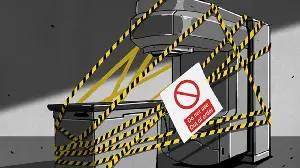Software bug of Therac-25
Published:
 Therac-25 is a medical linear accelerator developed in the 1980s by the Canadian company Atomic Energy of Canada Limited (AECL). The machine was designed to deliver high-energy radiation to treat cancer patients, and it was used in several medical facilities throughout the world. However, the Therac-25 was also responsible for several radiation overdose accidents due to a software bug known as a “race condition” associated with its command screen, which resulted in severe injury and even death.
Therac-25 is a medical linear accelerator developed in the 1980s by the Canadian company Atomic Energy of Canada Limited (AECL). The machine was designed to deliver high-energy radiation to treat cancer patients, and it was used in several medical facilities throughout the world. However, the Therac-25 was also responsible for several radiation overdose accidents due to a software bug known as a “race condition” associated with its command screen, which resulted in severe injury and even death.
The Therac-25 was an advanced machine that used computer technology to control the delivery of radiation to patients. However, due to a number of software bugs, the machine was prone to errors. A race condition occurs when multiple processes are trying to access and modify the same shared resource at the same time, leading to unpredictable and incorrect behavior. In the case of the Therac-25, the race condition was caused by a bug in the software that controlled the command screen. This bug caused the machine to incorrectly interpret commands, resulting in radiation overdoses. The most significant of these errors occurred when the machine was set to deliver a low dose of radiation, but instead delivered a much higher dose. This resulted in several cases of radiation overdose, which caused severe injury and even death.
The race condition in the Therac-25’s software was particularly dangerous because it could occur in the background, without any indication to the operator that an error had occurred. This means that the operator could be unaware that the machine was delivering incorrect doses of radiation. The incident raised several questions about the responsibility of manufacturers and operators of medical equipment, and led to changes in regulations and industry standards.
One of the key issues with the Therac-25 was the lack of proper testing and safety measures during the development and production of the machine. The software bugs that caused the accidents were not discovered until after the machine was in use, and the manufacturer had not adequately tested the software or considered the potential risks.
Additionally, the operators of the machine were not properly trained to recognize and respond to errors, which contributed to the severity of the accidents. There was also a lack of communication and coordination between the manufacturer and the operators, which further hampered the ability to identify and address the issues with the machine.
In response to the accidents caused by the Therac-25, the medical industry has taken steps to improve safety and oversight. There are now strict regulations and standards for the testing and safety of medical equipment, and operators are required to receive proper training and education on the equipment they use.
In conclusion, the Therac-25 incident serves as a cautionary tale of the potential dangers of technology when proper testing and safety measures are not in place. The tragic accidents caused by the machine led to changes in regulations and industry standards, and highlighted the importance of proper testing, safety, and communication in the development and use of medical equipment.